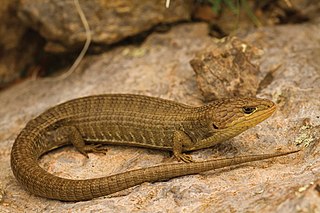Related Research Articles

Barisia is a genus of lizards in the family Anguidae. The genus is endemic to Mexico.
Parabelminus is a genus of bugs in the subfamily Triatominae. The species of this genus could be found in Brazil, specially in Rio de Janeiro and Bahia. It is a vector of Chagas disease.

The Chamaemyiidae are a small family of acalyptrate flies with less than 200 species described worldwide. The larvae of these small flies are active and predatory and are often used for biological control of aphids, scale insects, and similar pests. Chamaemyiid fossils are poorly represented in amber deposits, but a few examples are known from the Eocene epoch onwards.

Kaniska canace, the blue admiral, is a nymphalid butterfly, the only species of the genus Kaniska. It is found in south and southeast Asia.

The Doryctinae or doryctine wasps are a large subfamily of braconid parasitic wasps (Braconidae). Numerous genera and species formerly unknown to science are being described every year. This subfamily is presumably part of a clade containing otherwise any or all of the Alysiinae, Braconinae, Gnamptodontinae, Opiinae and Ypsistocerinae, and might be most closely related to the last one of these. Whether the Rogadinae are also part of this group is not known.

Gryllacridinae is an Orthopteran subfamily in the family Gryllacrididae.

Spasskia brevicarinata is a species of parasitoid wasp native to the Guizhou and Yunnan provinces of China. The female body is 8.2 millimeters long, with 7.3 millimeter forewings. The ovipositor, when fully extended, measures 5.5 millimeters long. General coloration is black, however, the first tergite is yellow. The fore and mid legs are also yellow, while the hind pair are reddish-brown and whitish-yellow. The antennae are dark brown, with a whitish-yellow stripe between the 11th and 15th flagellomeres No males of the species have been observed to date. The species name is derived from Latin brevi, meaning "short" and carinata, the word for "carina". This literally means that the species has a short dorsal carinae as part of the first tergite.

Spathius galinae is a parasitoid of emerald ash borer. The known range of S. galinae extends from the Russian Far East to South Korea. It is currently approved for release in some areas of North America as part of a biological control program against emerald ash borer.

Dinotrema is a genus of wasps in the family Braconidae. Species are amongst the largest parasitoid wasps in the tribe Alysiini (Alysiinae). There are approximately 350 species described around worldwide.

Heterospilus is a genus of braconid wasps in the family Braconidae. There are at least 130 described species in Heterospilus.

Ivondrovia grangeri is a species of parasitoid wasp belonging to the subfamily Doryctinae of the family Braconidae. It is endemic to Kenya.

Ivondrovia seyrigi is a species of parasitoid wasp belonging to the subfamily Doryctinae of the family Braconidae. It is endemic to Madagascar.

Colastes is a genus of braconid wasps in the family Braconidae. There are at least 80 described species in Colastes.

Ondigus is a genus of braconid wasps in the family Braconidae. There are at least two described species in Ondigus, found in Mexico and Central America.

Heerz is a genus of braconid wasps in the family Braconidae. There are at least four described species in Heerz, found in Mexico and Central America.

Lissopsius is a genus of braconid wasps in the family Braconidae. There are at least three described species in Lissopsius, found in Mexico and Central America.

Taeniopoda is a genus of horse lubbers, fairly large grasshoppers in the family Romaleidae that are native to southwestern United States, Mexico and Central America. There are about 12 described species in Taeniopoda. Taeniopoda is very closely related to Romalea, leading some recent authorities to consider the former a junior synonym the latter.
Orestes botot is a species of stick insects native in Vietnam.
Hormius is a genus of parasitoid wasp in the subfamily Hormiinae first described by Christian Gottfried Daniel Nees von Esenbeck in 1818.
References
- 1 2 Belokobylskij, S.; Zaldivar-Riveron, A.; Castañeda-Osorio, R. (2018). "Revision of the Afrotropical genus Ivondrovia Shenefelt & Marsh, 1976 with description of a new species". ZooKeys (747): 87–100. doi: 10.3897/zookeys.747.24351 . PMC 5904487 . PMID 29674905 . Retrieved 3 April 2018.